Boudoir photography tips every aspiring boudoir photographer needs to know.
Boudoir photography tips shared by successful boudoir photographers are in high demand as budding boudoir photographers turn their attention to this specialty photography genre.
Boudoir photography empowers women (also, everyone) to feel comfortable in their own skin and helps viewers to appreciate the beauty of the human form. Boudoir photos are intimate, private, and sometimes… mysterious.
In this article, we have compiled helpful boudoir photography techniques shared by photographers that will help you kick-start your learning in boudoir photography.
14-day free trial. No credit card required.
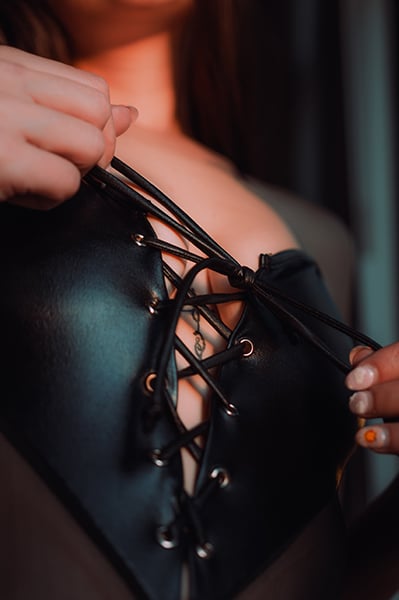
Introduction: boudoir photography shoot – for beginners.
Boudoir photography shoot has become an increasingly popular genre of photography; in the past five years it has experienced significant growth. It’s a style of portrait photography that emphasizes the beauty and curves of the client’s body, and often includes a luxurious session experience.
In boudoir portrait photography, common locations include a bedroom with minimal furnishings or a studio where tasteful elements are purposefully placed in the background. The place could also be a spacious and beautiful location of the client’s choice where there isn’t clutter or distractions in the background.
Natural sunlight is often the preferred lighting for both portrait and boudoir photography. Seasoned boudoir photographers love the soft natural light of the sun as it rises in the morning and sets in the late afternoon to avoid glare. Many would use props like light-colored curtains to diffuse the light for shooting.
Simple portrait photography poses include standing and sitting positions where you will get the subjects to use their hands to make gestures on their faces. In boudoir photography poses, photographers direct the subject to make poses that accentuate their chest, lower back, hips, and legs to highlight their sensuality and power.
When considering what gear you’ll need, 35mm and 50mm lenses are the best focal lengths for most indoor portrait photography. 35mm lens is great for including a little more of the environment around the subject, while 50mm will give tight shots of body and face without the image distortion.
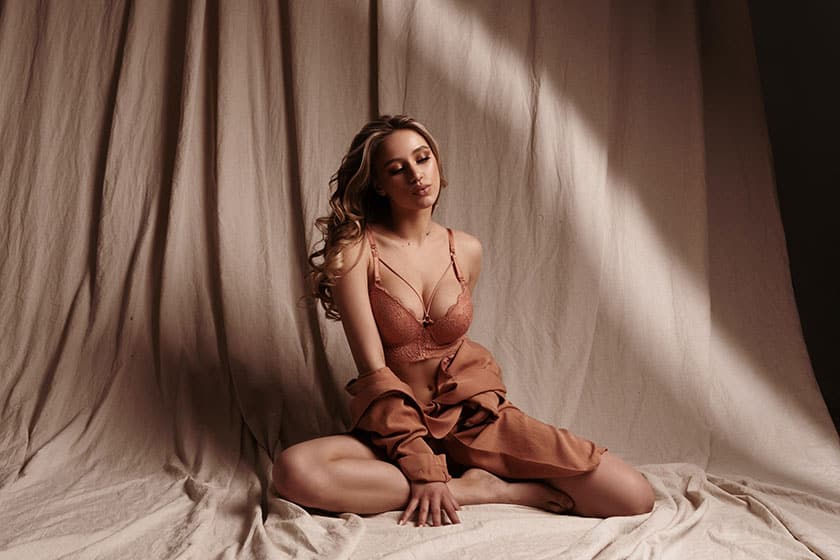
How to direct poses for boudoir session.
How you direct the subject to pose for boudoir sessions is vital in boudoir photography. First, you need to visualize the type of poses you want in your mind before guiding your subject. Keep the instructions simple and executable, so that your subject can follow them easily without guessing. If you can demonstrate them as well so your subject can see what you want them to do, that will go a long way.
Avoid telling the subject to look sexy in shooting boudoir photography as it’s a vague direction, and one person’s interpretations of that word could differ from one to another. This can also instantly put someone on edge and kill the mood and connection you’ve built thus far in the session. Instead, tell them what to do with the exact steps to achieve the type of sexiness you have previously envisioned.
Boudoir poses.
Great boudoir poses will not only help accentuate the curvatures of the subject but also cover up the body parts that you don’t want to include in boudoir photographs. Here are six well-known boudoir poses with helpful tips; feel free to make new ones with your limitless creativity.
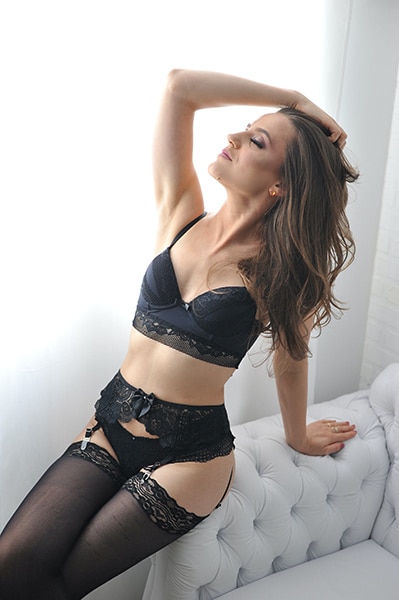
Simple boudoir poses.
- For simple boudoir poses, tell the subject to take her right leg and cross it in front of her left, then lean her chest forward. This will create a beautiful look that accentuates the curves of her thigh and hips.
- Another pose is to have the subject turn and face the side, take one step forward and point one toe, then tilt her head by looking up with her hand reaching to touch her forehead.
- The last simple boudoir pose is to have your subject crisscross her steps, pulling the robe off her shoulders but caught in her wrists as she strolls slowly away from your camera.
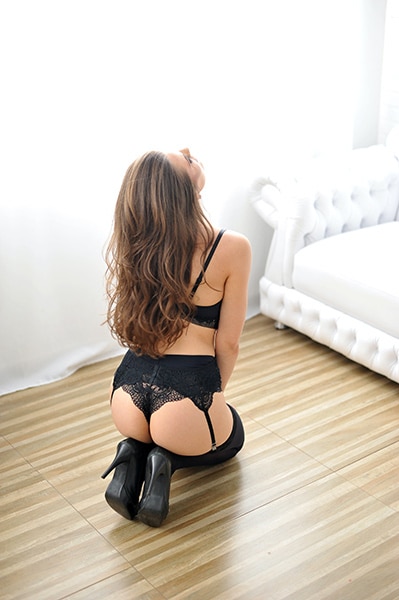
Edgy boudoir photography poses.
- One edgy boudoir photography pose is telling the subject to get into the “cat position” with her upper body lowered down, hips arched and tilting up her calves in high heels. Shoot from the angle of her hips at eye level.
- Try asking your subject to lean her back against the wall, toss her hair to one side, cross her legs, pop her hips, and bring her arms up by holding her wrists with her eyes looking away/down.
- Guide your subject to sit on her knees with thighs slightly parted, left arm behind her body, back arched, head tilted to the left with right finger touching lips. Take the shot at eye level.
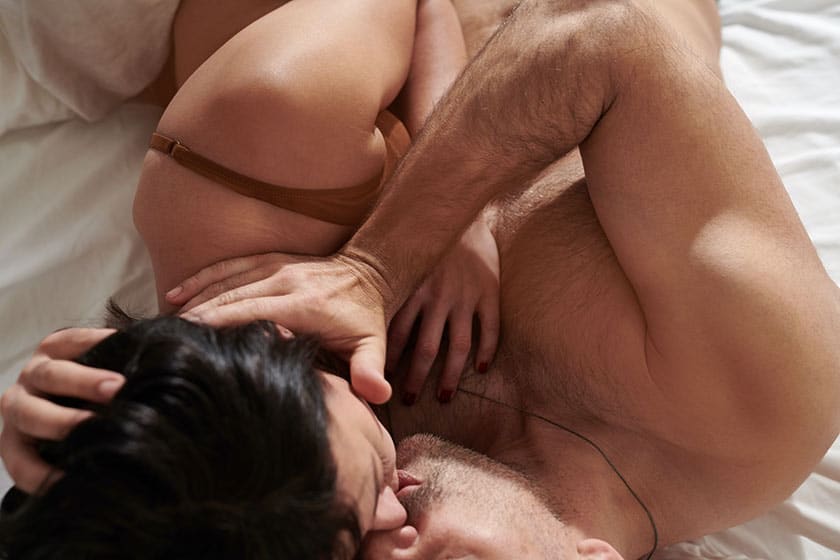
Couples boudoir photography poses.
There are many sensual poses for couple boudoir photography.
- Ask the couple to hold each other like they would on a dancing floor. Have the man pull up the woman’s dress, pull the straps off of her shoulders, or lean in for a kiss.
- Another sensual couple boudoir photography pose is to have the woman leaning against the wall with both of her arms up and holding her wrists. Ask the man to lean in to hold her hand while lifting one of her legs up and holding her thigh.
- Switch positions so that the man’s back is against the wall and the woman leaning towards him. The man places his hands on her hips and looks into her eyes as she looks away at the camera.
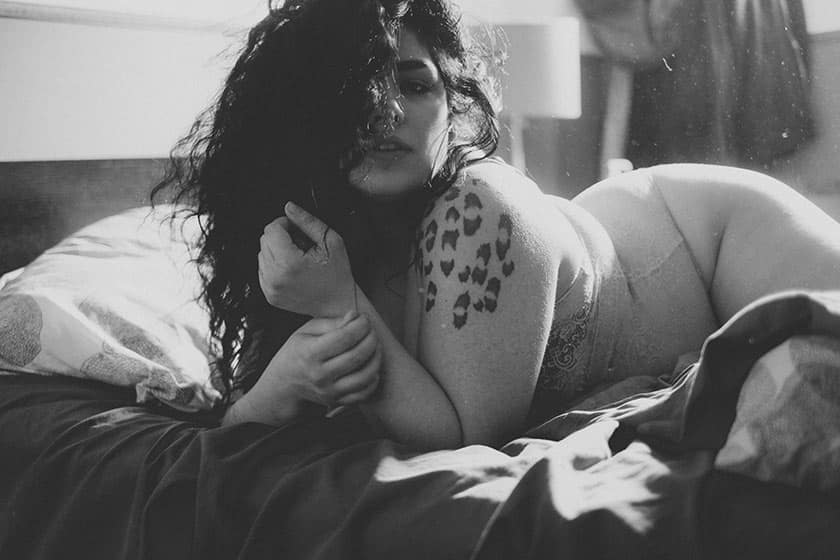
Plus-size boudoir poses.
- One of the best boudoir plus-size poses is to have the client leaning on her back against the edge of the bed with hands held together with her wrists over her head.
- Another pose is asking the subject to sit on her knees with her thighs apart, her body arched slightly back while holding both hands together by the wrists in front of her groin.
- Tell your client to move her arms away from the camera and push her elbows back while standing.
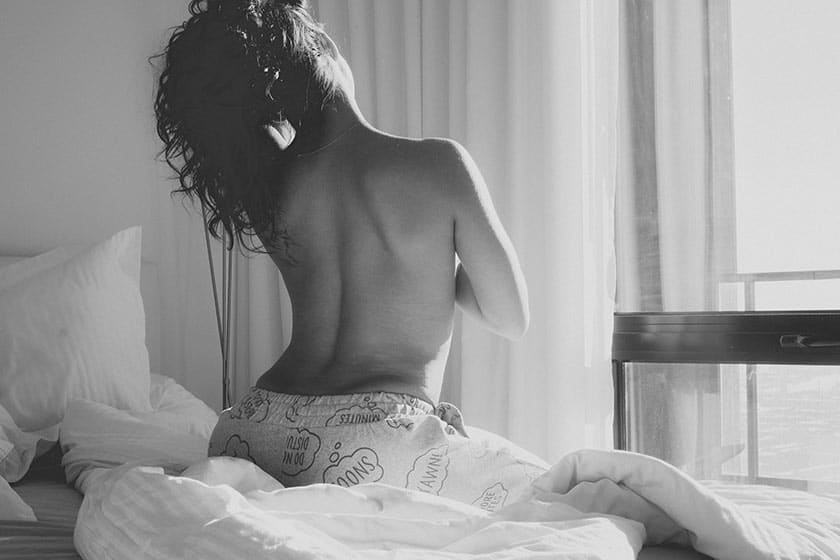
Boudoir poses on bed.
Another popular way to pose your subject to get some really stunning boudoir poses is to have your subject posed on the bed.
- Tell the subject to bring her knees up, her feet flat, and her toes pointed. This will make her legs look longer and tone up her muscles.
- Direct your subject to lie on her stomach, ask to bring her feet up, and point her toes. Then ask her to slide her elbows out & forward while running her hands through her hair.
- Another bed pose you can try is to tell the subject to lie on her side, cross & bend one thigh over the other while propping the rest of her body up by leaning on just one elbow.
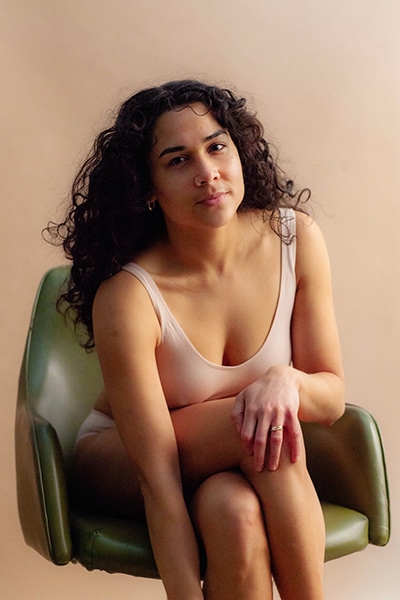
Boudoir poses that hide stomach.
Boudoir photography is all about empowerment and helping people feel comfortable int heir own skin, but that being said, a lot of people do not like the look of their stomach. Despite the aim of boudoir to embrace your body, some people may ask that you try to minimize the look of their stomach – so here are a few poses you can try that will hide your subject’s stomach.
- Get the subject in a sitting position on a bed or a couch with her knee bent on the same side that you’ll be shooting from.
- Place things like pillows or foreground items in front of her stomach before snapping that shot would also hide her belly.
- You can also have the subject straddle a prop (pillow or chair) and have her lean back into a sexy pose. That’ll hide her stomach, too.
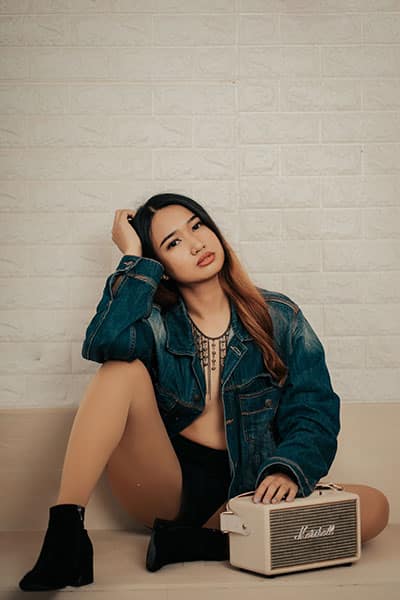
Boudoir props.
Bringing props to a boudoir shoot will enrich the photography and highlight the details you want to draw attention to in the photos. Items like tasteful (not cheesy) veils, high heels, foreground elements, mirrors, and robes are great boudoir props.
Try bringing some extra visual interest to the background of your scene. Adding a couple of plants to add some greenery to the environment will add context and help make it look interesting. Blankets, art, and other decorative elements can liven up the background without feeling intrusive to the images. Scented candles are another great prop to keep around as they add a relaxing and sensual aesthetic and help clients relax and liven up the experience.
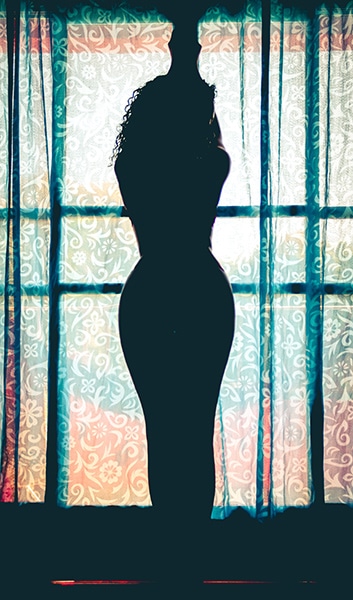
Boudoir lighting tips.
Lighting is the most vital element in boudoir photography. Many boudoir photographers make the mistake of focusing on poses and overlook the lighting; therefore, many boudoir photos don’t stand out and pop.
Here are five boudoir lighting tips you want to use in a shooting session.
- Natural light: Natural light, especially when it’s coming through a window, will create a beautiful soft light that is flattering to you subject and provides a lot of flexibility when shooting. If you find the light is too harsh you can cover the window with a sheer white curtains to diffuse the light, or if you need reduce how dramatic the images look, you can use reflectors to fill in some of the shadows.
- Front light: To get a nice even light across your subject, try lighting them from the front. You can achieve this by placing yourself between the light source (window, soft box, etc) and the subject. Have your subject facing the light. This will reduct the look of shadows, as well as wrinkles and other “imperfections” which, of course, we recommend be embraced and celebrated.
- Silhouette: If you want to create a silhouette effect try placing the light source behind your subject and expose for the highlights so that your subject is primarily in shadow. You can play around with the exposure to try and pull a bit of detail from some of your subjects curves. This can create a very sensual and moody image.
- Overhead lighting: Overhead lighting is often used in studio boudoir photography. It’s great for shooting the subjects in laying poses when natural sunlight isn’t available. Many boudoir photographers use a combination of continuous strobe hybrid light and strip softbox as a modifier to provide a directional highlight to the subject’s body.
- Lighting in various positions: The key light, known as the first light, illuminates one side of the subject’s face. Place the key light at the photographer’s 4 o’clock position, the second (accent) light at 1 o’clock (behind the subject), and the third (fill) light placed in the 5 o’clock position will give the image a three-dimensional and tasteful look.
Important documents for boudoir photography shoots.
Legal documents for boudoir photography shoots are important for the boudoir photography industry.
These documents serve as legal proof that the modeling clients have voluntarily given permission and legal consent to use and display their images for commercial purposes by the photographers. They’ll protect the photographers from potential lawsuits and makes sure that everyone understands and is in agreement with the terms of usage.
Boudoir photography contract.
The boudoir photography contract is one that creates the relationship between you, the boudoir photographer, and the modeling client, your subject. It regulates things like non-refundable payments, responsibilities of each party, delivery schedule, cancelation policies, file storage, reschedule policies and fees, etc.
This document sets the expectations with your clients, so they’ll know what to expect from you. Boudoir photography contract is the core document that gives you legally binding support should things go wrong between you and the clients.
Boudoir photography consent form.
Boudoir photography consent form could either be a separate form or be included in the clauses as part of the boudoir photography contract.
Items in boudoir photography consent form could include but are not limited to: consent to release of images, copyright, usages in marketing and advertising, the limit of liability, social media publication, reprinting, etc.
Both the photographer and the clients should sign the consent forms, and each will retain a copy.
Boudoir model releases.
Boudoir Model Releases give boudoir photographers permission to release the photos, and they are presented to the modeling clients separately from the boudoir photography contract.
- General model release: General model releases are a means for a photographer to have permission to use the photos from the session for promotional or commercial purposes. It’s important to obtain a model release whether it’s for paid, or unpaid work as it protects you from liability and licensing issues that may arise in the future. The best time to bring up the subject is during the interview with the modeling client, prior to the shoot.
- Limited model release: Limited model releases are suitable for occasions when a modeling client agrees to let you use some of the images, but not all of them. Boudoir photographers are given permission to use a certain number of images or specific images identified by the file number.
- Anonymous model release: Anonymous model releases are used in situations when the boudoir photos were taken without the model’s face (or faces being cropped out during editing), rendering the word ‘anonymous.’ If your modeling client doesn’t want to be recognized in her boudoir shots, this type of release is a good option.
Boudoir photography tips for clients.
In most situations your models will be your paying clients. Here are 10 helpful boudoir photography tips for you and your clients.
1. Communicate
As a boudoir photographer, giving your clients clear directions and supportive comments will let them know how they can improve their poses during shooting sessions.
2. Hair
Hair is another detail that you can keep an eye on. Messy bedhead can work very well in boudoir photos and add an extra layer of sexiness, but it’s also a good idea to discuss the look they want ahead of time and recommend they come with their hair already done, or hire a hair and makeup artist to be present at the shoot to bring the look to life.
3. Relax
Clients will often feel nervous at the beginning of the boudoir photo shoot. Take some time to just chat and ease the tension. Those extra few minutes will go a long way in building a connection and rapport with your subject throughout the shoot. Playing soft music in the background is also helpful help ease into the session, instead of just hearing the clicking of the shutter.
4. Buffer time.
Avoid booking back-to-back shooting sessions and allow time some wiggle room. This will give you enough time to build rapport & comfort level with clients during shooting sessions and will give you some breathing room in case things run a but over or if you need to reset the scene before your next client arrives.
5. Nothing personal.
Be prepared to receive negative comments from your clients and have suggestive ideas ready to touch up the photos as they self-critique the way they look. It’s up to you to make sure they feel comfortable and confident throughout the session, but it is possible you will come up against this at some point. Helping your client see the beauty in the images is part of the job, but so is taking critique.
6. Wardrobe
Feel free to help your clients with wardrobe inspiration if they seek your advice. Have handouts ready to dish out, including photos of outfit options and the places to get them. Chat with your client before the shoot to understand their expectations and share suggestions for attire based on that conversation.
7. Keep an open mind.
Once the subjects feel relaxed and comfortable during the photo session, be open-minded to all kinds of possibilities because you might be surprised at what works. Let yourself be creative and experiment.
8. Ask for selfies.
Don’t be shy to ask your clients for selfies, or their social handle, before the shoot. Either of these can help photographers understand their client’s style and often make it easier to recommend outfits that would best accentuate the client’s body.
9. Patience
Like the rest of us, your subjects have emotional ups and downs, and may sometimes come into a session in an uncooperative mood. Stay positive and be patient when things don’t go according to plan. Focus on building a relationship and work within your subject’s limits. If they don’t want to do a certain pose, don’t force the issue. It won’t end up looking good and can change the atmosphere of the rest of the shoot.
10. Context
Focus on the context in boudoir photo shoots. How your subject interacts with the environment will impact the sensuality you want to convey in the images.
Boudoir photography camera settings.
As with any style of photography, getting the camera settings right is very important. We will share some basic camera settings for boudoir photography.
1. ISO
Camera technology is getting better with every camera release and things like low light performance has made major strides so you don’t need to worry about ISO as much as you used to. ISO is the measure of how sensitive your camera sensor is toward light – the higher the value the more sensitive. The lower your ISO, the less noise you will get in your images. Keep in mind that the type of lighting you choose may dictate whether you need to push your ISO in order to keep your shutter speed high enough to avoid motion blur. The more control you have over the amount of light in your scene, the more control you have over your ISO.
2. Aperture
Depending on your situation, shooting a boudoir photo between F/1.4 and f/2 will give you a beautiful look with a very shallow depth of field. This will blur our a lot of the foreground and background and create a beautiful and artistic aesthetic. If you want your images to have more detail in the background, increase the aperture.
3. Shutter speed.
In boudoir photography, the subject isn’t moving very much during a photo shoot. You can keep the shutter speed low to at least 1/200 and make sure there is no camera shake or motion blur before snapping that photo. Feel free to increase shutter speed as you see fit.
Build an online portfolio website you love
Put your boudoir photography in the spotlight.
